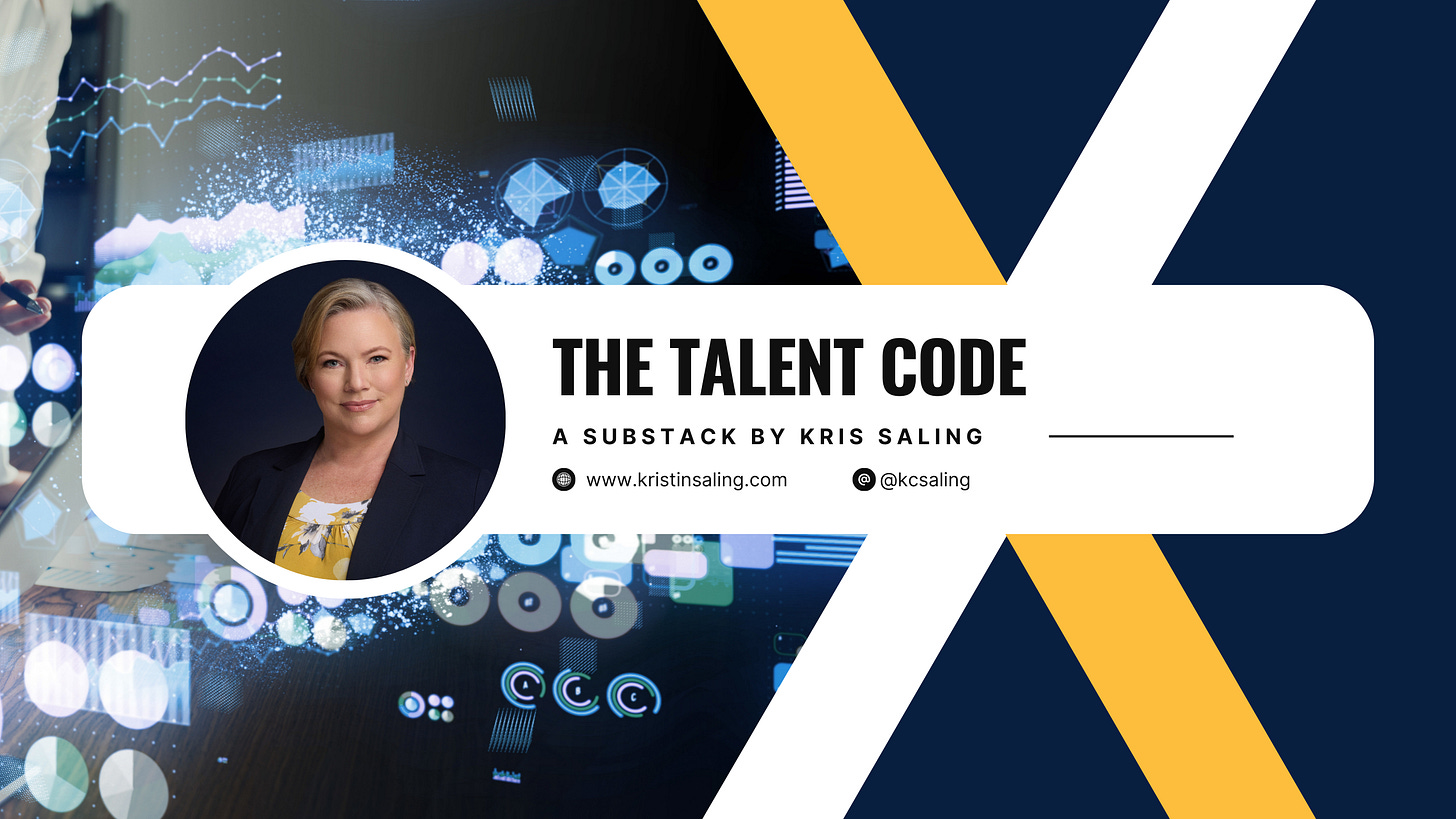What kind of change-maker are you? And how does that impact change?
There are lots of different ways to make an impact on an organization, and your job as a change-maker is to figure out when to play it loud and when to play it quiet, when to make a big splash and when to “set conditions,” when you need to carefully set a complicated strategy in motion and when you really need an impact to make people pay attention.
We’ve talked about several topics in change management over the last couple weeks—inspecting your business for the drivers of change, disruption vs. transformation, leading from the middle, and assessing whether or not your culture is ready for the kind of change you’re looking to drive.
I’d like to cap off this change segment here at The Talent Code with a look at you as the change-maker, and the different types of roles as a change leader you can play, and when it makes the most sense to wear each hat.
Let’s decode it. 🚀
Three Archetypes of Change Leader
And what each one can do for your organization
For research I’m doing for my next book, I wanted to move beyond just defining change agents and to look at different archetypes. Because there are lots of people you can label “change agents,” but they impact the organization in very different ways.
Every organization has people quietly—or not so quietly—trying to make things better. They might not have a title, they might not sit at the head of the table, but they are constantly scanning the system, spotting inefficiencies, challenging outdated thinking, and imagining a better way.
I’m sure there are many ways to slice this, but my work has shown me three dominant archetypes that show up different ways at different levels: the Rebel, the Reformer, and the Architect.
These aren’t job descriptions, they’re postures—orientation toward how change happens, how risk is managed, and how systems are engaged. Let’s take a deeper look at these, and then look at how you might move between them during your career.
The Three Archetypes of Change
1. The Rebel: the spark that starts the fire
The Rebel is the rule-breaker. They challenge the status quo, speak uncomfortable truths, and are often the first to name what others are thinking. They spot rot and call it rot out loud. They’re the ones saying, “Why are we still doing it this way?” They aren’t always easy to work with—but they’re essential for shaking loose inertia.
They’re often found at the edge of the organization, where they can test ideas in lower-risk environments. They can also be early-career professionals who aren’t yet indoctrinated into “the way things work” and that fresh perspective can be extremely powerful.
🟢 The pros:
They catalyze awareness of urgent issues
They break organizational inertia
They attract other unconventional thinkers
🔴 The cons:
They can be dismissed as difficult or “not a team player”
They often lack institutional power or platform
They risk burnout if constantly in conflict with the system
Many times throughout my career I’ve been the Rebel. I’ve advocated for programs prioritizing capability over seniority, which challenges a lot of sacred cows in the U.S. military. I’ve been very vocal in my refusal to accept one-size-fits-all talent systems and my standpoint that sometimes treating people all the same is actually unfair. It made me “that person” in the room, even if it opened the door for broader conversations.
I sometimes still need to be that person who colors outside the lines, who asks for forgiveness rather than permission, but it’s one of those roles that is only tenable for a short time at my level. If you’re too outside the lines, you break trust, which means you won’t get opportunities at best or you’ll get cut out of the change process at worst. This is a role you take on when you need to shake up the conversation, but give yourself the ability to take cover in another role that engenders enough trust to get things done.
2. The Reformer: translating vision into action
Reformers operate inside the system and know how to navigate it. They’re the connectors who link ideas to structures, politics to process. Reformers are often mid- to senior-level professionals with deep institutional knowledge and strategic influence.
They’re less interested in breaking the rules and more interested in rewriting them. They understand that progress often depends on compromise, coalition-building, and learning the language of those in power. Their strength is knowing just how far they can push without triggering the resistance that stalls change.
🟢 The pros:
They know how the system really works
They can influence formal policy and process
They bridge between rebels and leadership
🔴 The cons:
They risk being seen as too slow or too political
They can lose momentum in a bureaucracy
They may struggle with perfectionism or waiting for “ideal conditions”
This has been my role for a lot of my later career, and is probably the one I’m most comfortable in. When you operate at high levels of government, going outside the lines often is met with swift retribution. You find strength instead in figuring out just how close to the edge you can color and making the absolute most of that space.
Aligning bold ideas with strategy and existing authorities has allowed me to create and anchor a whole lot of change, but I’ve also been accused of playing it too safe, becoming too bureaucratic or part of the establishment, or chasing promotions.
Still, I’ve learned that without the infrastructure you create in this kind of role, ideas collapse. Here, I can build credibility while still pushing the system to adapt and evolve.
3. The Architect: building systems that outlast people
The Architect builds the structures that make change scalable, resilient, and long-lasting. Architects think in systems—processes, culture, and feedback loops–and design for the future. They aren’t satisfied with fixing symptoms; they want to redesign the whole underlying machinery.
Architects are often senior leaders, enterprise strategists, or trusted internal advisors. But they can also be embedded tacticians who understand how to build models, frameworks, and playbooks that outlast individuals. Their focus isn’t speed but durability.
🟢 The pros:
They build lasting infrastructure for change
They focus on sustainability, not just visibility
They align tools, policies, people, and purpose
🔴 The cons:
Their work may be invisible or underappreciated
Change may be slower and less headline-worthy
They need deep systems knowledge and long-term support
I don’t get to wear this hat often, but I’ve done this in two situations—one, when I’ve been building innovation teams to keep leading change in an organization, and another, when I’ve been designing teams to instantiate change in regulation, law, or statute. My work designing an innovation team to support Army Recruiting had me wearing this hat quite a bit, designing a foundation for future change agents, not just solving today’s problems.
In this role, I had to think about data infrastructure and technology, human workflows, project and product plans, and cultural change all at once. It wasn’t flashy, but it’s the kind of change that sticks, and keeps an organization changing.
These roles aren’t fixed. I’ve worn all of these hats, sometimes many hats at once. Most successful change-makers cycle through all three.
You might find yourself starting as a rebel, shifting into a reformer once you gain credibility, and later becoming an architect as your scope expands. And you might find yourself putting on your rebel hat before you get up to a podium and giving your organization a very sharp push toward change if needed.
The goal isn’t to pick a role and stay there. The goal is to understand which role you’re inhabiting now, which one your organizational context demands, and which one will help you make the most impact.
Quick Self Assessment:
What Kind of Change-Maker Are You Right now?
Choose the statement that most resonates out of each of the following:
My mindset:
I see a problem and I’m willing to challenge the status quo to fix it.
I understand how this system works and I’m working to improve it from the inside.
I want to design long-term structures that enable others to lead change, too.
How I spot problems:
I call out broken processes as soon as I see them.
I work behind the scenes to redirect or adjust processes that no longer serve.
I look at patterns and trends to redesign systems so they stop breaking in the first place.
How I build influence:
I challenge people directly, even if it ruffles feathers.
I earn trust by demonstrating competence and aligning change with existing priorities.
I shape thinking by building structures and frameworks that others can follow.
How I deal with resistance:
I push harder or find a way around it.
I adapt my approach and argue for mutual benefit.
I redesign the conditions so resistance is less likely to form.
How I define success:
If I shake things up and make people think differently, I’ve done my job.
If my idea got implemented and made a visible impact, I’m good.
If things keep improving after I’m gone, that’s success.
How I see my role:
I’m the spark that gets change started.
I’m the engine that moves things forward.
I’m the scaffolding that makes change sustainable.
Scoring:
For every 1 you selected, give yourself 1 point
For every 2 you selected, give yourself 2 points
For every 3 you selected, give yourself 3 points
Score 6-9: Rebel
You’re a catalyst, challenging what doesn’t work and pushing your organization to see the cracks. You’re most comfortable at the edge of the system, testing boundaries and breaking inertia. Just be mindful of burnout and backlash. Your boldness is powerful, but pairing it with strategic influence will help your ideas take root.
Score 10-13: Reformer
You’re operating from the inside, translating vision into action. You know how the system works and how to bend it so that it doesn’t break. You’re credible, collaborative, and persistent. Your next growth opportunity may be in thinking bigger, shifting from the process improvement to system redesign.
Score 14-18: Architect
You’re building lasting infrastructure. Your focus is on culture, structure, and sustainability. You think about systems that survive turnover and scale beyond any one person. Just remember to stay close to the ground. Keep listening to the rebels and reformers who are living the friction day-to-day.
This assessment and these roles aren’t about locking yourself into a role—they’re about seeing clearly where you are, what’s working, and what posture might serve you best in the change you’re trying to lead.
Think and reflect about these roles, where you see yourself, and where you might build yourself a team or a coalition of collaborative change agents to shore up where you might have weaknesses.
Lay Out Your Blueprint for Change
If there’s one truth to hold onto in today’s work environment, it’s this: change is no longer something you initiate occasionally, it’s something you must learn to live inside of. The ground keeps shifting, tools evolve, missions adapt, people move. What used to be a clearly defined project is now a continuous condition of leadership.
This means we need to change the way we think about change itself. And how we lead.
The real work of change isn’t about dramatic announcements or shiny new tools—it’s about designing structures that support real, human-centered progress over time.
It’s about drawing blueprints for something better.
That blueprint might be a reimagined workflow. A new way of running meetings. A better way to identify and grow talent. A smarter process for making decisions.
You can do this.
Whether you’re a Rebel, a Reformer, or an Architect.





check out https://substack.com/@ecosysmetacognition Jason's work on this persona stuff is majik. Also have your read the 4 Tendencies from @gretchen rubin?
Scored an 11 - may not know how all of the system works but I’m learning!